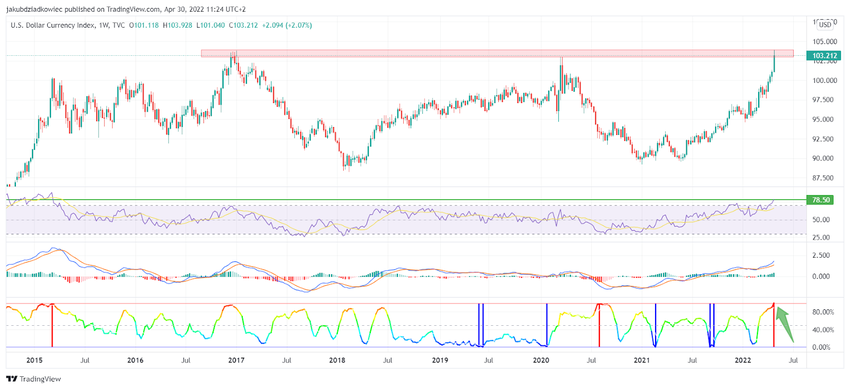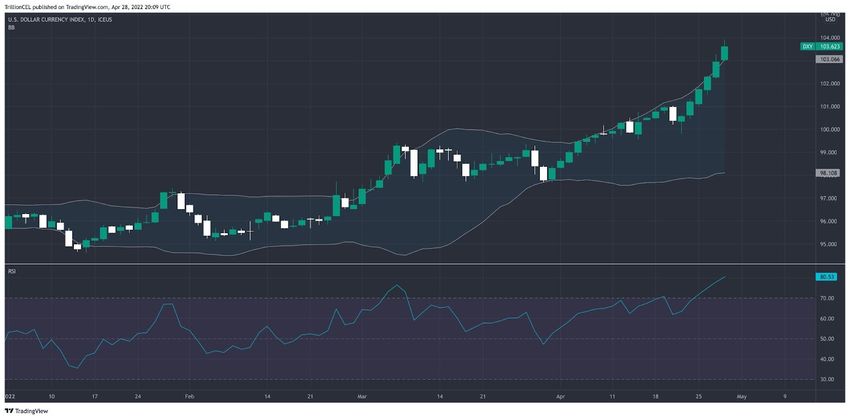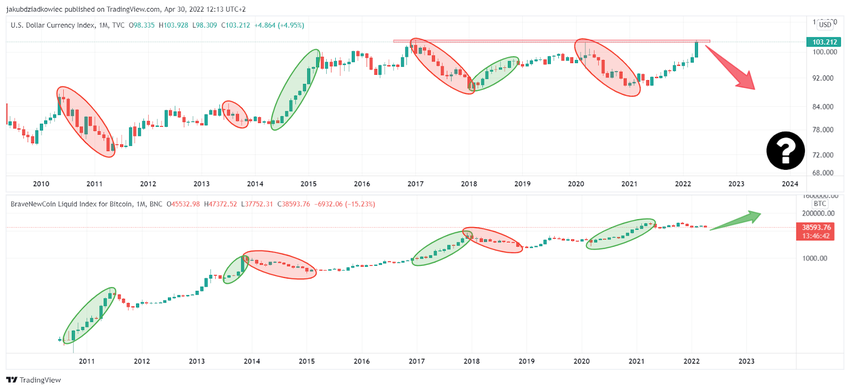The U.S. Dollar Index, which has experienced rapid growth in recent weeks, has reached long-term resistance. Much depends on the DXY’s further movements, not only in the broad financial sector, but also in the Bitcoin and cryptocurrency markets.
A rise in the U.S. Dollar Index is often a signal of uncertainty and fear in financial markets. Moreover, the DXY has a long-term negative correlation with the price of Bitcoin and the cryptocurrency market.
The latest releases of quarterly reports from major U.S. companies came in below expectations. Then, investors continue to take into account the unstable global situation with the war in Ukraine and the ongoing threat of COVID-19 pandemic in China. Rising inflation in Western countries and rising interest rates are additional factors that signal the danger of a recession.
SponsoredAll of this creates an ideal environment for liquid cash, so the DXY rises are no surprise. Until when will they last? Will the long-term resistance the dollar has just faced end its rise and trigger a rebound in the financial markets?
Bullish DXY reaches long-term resistance
On April 29, the U.S. Dollar Index reached an area of long-term resistance (red rectangle), recording a peak just below the 104 level. In the weekly chart, we can see that this area has been in place since the turn of 2016-2017 and was retested in March 2020.
In January 2021, the DXY bottomed at the 82 level, after which the index consolidated for 5 months to begin a 16.5% rise in May 2021 that continues today. In the meantime, the dollar managed to break through and confirm as support two important resistance levels. The first at 94.5 (red line) and the second near 98 (yellow line).

The weekly technical indicators are giving very bullish readings, but at the same time are signaling an overbought level has been reached. The RSI is at 78.5 (green line) – a high that the DXY last recorded in March 2015. MACD is generating consecutive green bars of bullish momentum and its histogram is rising.
Meanwhile, the BBWP, which is a measure of volatility, generated its first maximum reading of 100% (arrow) since August 2020 and its second red reading in 7 years. This means that upside momentum has peaked, and a cooldown period is to be expected.
Sponsored Sponsored
A return to earth?
Even more overbought readings are provided by the daily chart, where we see RSI above 80 and extreme signals from BBWP. DXY reacted to reaching resistance yesterday with a gentle decline.
A slight bearish divergence appeared on the MACD (red lines). On the other hand, the RSI, despite being clearly overbought, is not yet giving any downward signals on the daily interval. However, if the long-term resistance level were to be respected, we can expect a correction to the 0.5-0.618 Fib retracement and validation of the 95-97 area as support.

Cryptocurrency market analyst @TheRealPlanC tweeted a chart of DXY in which he highlighted high readings on the RSI. At the same time, he drew attention to the Bollinger Band, above whose upper range DXY has been closing for several days. This is a bullish signal of a strong uptrend, but the analyst comments that “return to earth [is] coming at some point.”

Correlation of DXY with BTC and the altcoin market
The DXY has a long-term negative correlation with the price of BTC. When the dollar index rises, the Bitcoin price falls and vice versa. It has not been this strong in every period, but the long-term monthly chart shows a clear relationship.

If the DXY’s period of strong growth were to end as it reaches resistance in the 104 area, it could be a bullish signal for Bitcoin and the overall cryptocurrency market. However, on the other hand, if the DXY breaks out above resistance, then BTC could continue its decline and plunge into a long-term bear market.
An additional argument for the first scenario was provided by another crypto market analyst @BTCfuel. In a tweet yesterday, he compared the inverted DXY chart with the historical price action in the altcoin chart from 2018-2021.

The inverted DXY chart is at long-term support and is in the process of confirming a breakout from a descending wedge pattern. A similar situation occurred in the altcoins chart in late Q1/early Q2 2020.
If this situation were to play out similarly for the inverted DXY, a dynamic upward move can be expected. In turn, this would lead to a sharp decline in the value of the U.S. dollar index and a hypothetical continuation of uptrends in traditional and crypto markets.
For BeInCrypto’s latest Bitcoin (BTC) analysis, click here.

